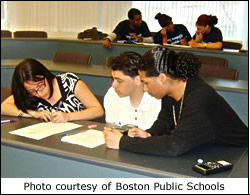Introduction
 In order for high school students to be engaged in reasoning and sense making in the classroom, the task—what students are asked to do—is critical. However, each item in this task library contains much more than a student work sheet. While linking the task directly with NCTM’s Focus in High School Mathematics: Reasoning and Sense Making, NCTM’s Principles and Standards for School Mathematics, and the
Common Core State Standards, each item addresses:
In order for high school students to be engaged in reasoning and sense making in the classroom, the task—what students are asked to do—is critical. However, each item in this task library contains much more than a student work sheet. While linking the task directly with NCTM’s Focus in High School Mathematics: Reasoning and Sense Making, NCTM’s Principles and Standards for School Mathematics, and the
Common Core State Standards, each item addresses:
- Task Design: What the task is asking students to do (see Task Purpose, Task Overview, Focus on Reasoning and Sense Making, Focus on Mathematical Content, Materials and Technology, Assessment and the Student Activity sheet)
- Teaching Design: How teachers might facilitate reasoning and sense making (see Use in the Classroom)
- Student Engagement: What student might actually do in the classroom (see Focus on Student Thinking)
| Task |
Purpose |
|
Horseshoes
in Flight

|
Students analyze the structure of algebraic expressions and a graph to determine what information each expression readily contributes about the flight of a horseshoe. This task is particularly relevant to students who are studying (or have studied) various quadratic
expressions (or functions). The task also illustrates a step in the mathematical modeling process that involves interpreting mathematical results in a real-world context. |
|
Taking a Spin

|
Although students are often asked to find the angles of rotational symmetry for given regular polygons, in this task they are asked to find the regular polygons for a given angle of rotational symmetry, a reversal that yields some surprising results. This task
would be most appropriate with students who have at least some experience in exploring rotational symmetry. |
|
Tidal Waves

|
Students analyze a problem faced by the captain of a shipping vessel. Students may use a range of functions to model the situation and reflect on their usefulness. Because trigonometric functions can be useful, this task would be particularly appropriate for students who
have had an introduction to graphing sine and cosine functions. |
|
Eruptions: Old Faithful

|
Students analyze data and make predictions. They will create a variety of graphical displays to discover trends in the data, then use those graphs to support their predictions. This task is appropriate for students familiar with line graphs and other graphical displays of
univariate data sets. |
|
Fuel for Thought

|
Students use mathematical reasoning to determine appropriate numerical measures and patterns in fuel consumption in order to inform consumer choice for vehicle purchasing. The task promotes a sophisticated use of number sense including careful attention to units.
It is accessible to beginning high school students. |
|
Bank Shot

|
Students compare their own reasoning strategies and those of their classmates, focusing on the strategies’ usefulness in determining how to make certain bank shots in billiards. This task is intended to involve multiple geometric perspectives and would be appropriate for students with an understanding
of similar triangles, rigid motions (especially reflections), and equations for lines and is designed to strengthen students’ understanding of these concepts. |
|
As the Crow Flies

|
The distance formula is often presented as a “rule” for students to memorize. This task is designed to help students develop an understanding of the meaning of the formula. It would be appropriate as an introduction (or review) of the distance formula for students who are familiar with the Pythagorean
theorem and coordinate systems. |
|
Over the Hill

|
Students determine locations on a hillside for a cell phone tower erected to provide a signal to people on the other side of the hill. They identify necessary information, represent the problem with a scale model, and answer questions in context. This task is
appropriate for students who have had experience in determining equations of linear functions through two points and in solving systems of linear equations. |
|
Cash or Gas

|
State lotteries in Florida and other states give winners a choice between cash and another prize, such as free gas for life. In this task, students will evaluate two prize options by discussing and making reasonable assumptions to simplify a complex
decision. This task is appropriate for students who can extrapolate quantities over time and are able to make conversions among different units of measure. |